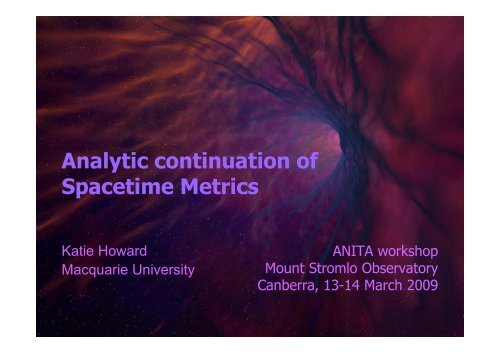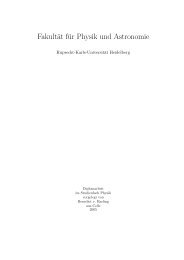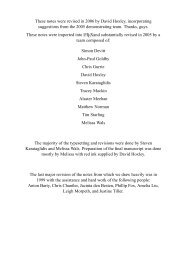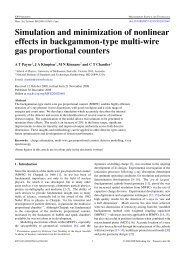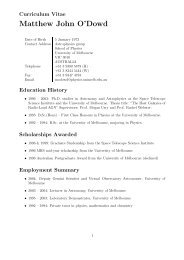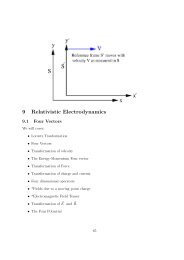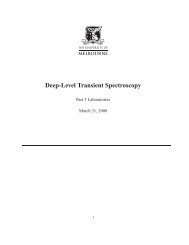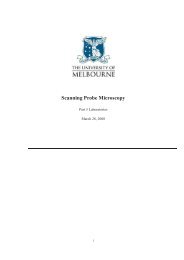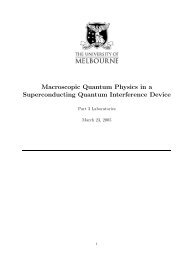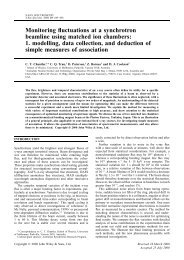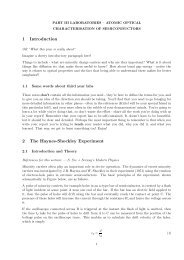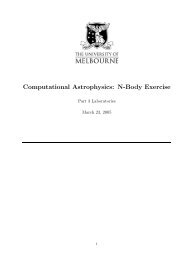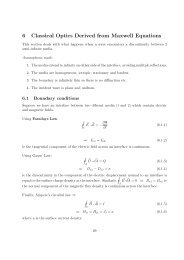Analytic continuation of Spacetime Metrics
Analytic continuation of Spacetime Metrics
Analytic continuation of Spacetime Metrics
You also want an ePaper? Increase the reach of your titles
YUMPU automatically turns print PDFs into web optimized ePapers that Google loves.
<strong>Analytic</strong> <strong>continuation</strong> <strong>of</strong><br />
<strong>Spacetime</strong> <strong>Metrics</strong><br />
Katie Howard<br />
Macquarie University<br />
ANITA workshop<br />
Mount Stromlo Observatory<br />
Canberra, 13-14 March 2009
Historical note<br />
The first public use <strong>of</strong> the term<br />
"black hole".<br />
- appeared in the Phi Beta<br />
Kapper journal "The American<br />
Scholar"<br />
(Vol.37, No.2, Spring 1968,<br />
pp.248) and in the Sigma Xi<br />
journal, "American Scientist"<br />
Vol.56 No.l Spring 1968, pp. 1-<br />
20.<br />
This page was sent to the<br />
authors by John Wheeler with<br />
his handwritten notes.<br />
-first postulated in 1783 by John<br />
Michell<br />
-the term “black hole” coined in<br />
1969<br />
-observational evidence starting<br />
in 1970s
Formulation <strong>of</strong> the problem<br />
-BH: regions <strong>of</strong> space from which nothing, not even light, can escape<br />
because gravity is so strong.<br />
-singularity is “clothed” inside EH where cosmic censorship prevails (we<br />
cannot see inside the event horizon)<br />
-can one See what happens "Inside a Black Hole"?<br />
-is it possible for a distant observer to receive information about the BH interior?<br />
-Can we get information about the region lying inside the apparent horizon?<br />
-investigate the interior <strong>of</strong> regular axisymmetric and stationary BH<br />
-the occurrence <strong>of</strong> singularities possible breakdown <strong>of</strong> GR ->QG??<br />
-what are the possible solutions? Are the solutions stable?<br />
-critical phenomena beyond spherical symmetry? conditions for predictability?<br />
-the final state <strong>of</strong> gravitational collapse ->spacetime singularities in the causal future <strong>of</strong> regular initial data,<br />
with divergence <strong>of</strong> curvature invariants and geodesic incompleteness; we expect continued gravitational<br />
collapse leading to a singularity<br />
-save the situation: spacetime singularities are "invisible" to external observers ->"cosmic censorship<br />
conjecture“ –unproven and the foremost unsolved GR problem.<br />
-under certain physical situations <strong>of</strong> gravitational collapse spacetime singularities, in the sense <strong>of</strong> causal<br />
geodesic incompleteness, must occur<br />
-we consider some fundamental questions concerning marginally trapped surfaces (apparent horizons), in<br />
Cauchy data sets for the Einstein equation.<br />
-What is the extension <strong>of</strong> spacetime beyond the singularity?<br />
Black hole interiors<br />
(a) Trapped surfaces<br />
(b) Singularities and inner horizon instability<br />
(c) Einstein-Rosen bridge on analytic extension
Black holes overview<br />
-for bodies <strong>of</strong> too large a mass, concentrated in too small a volume, unstoppable collapse<br />
will lead to a singularity in the structure <strong>of</strong> space-time.<br />
-the term ‘singularity’ refers to a region where the conventional classical picture <strong>of</strong> spacetime<br />
breaks down<br />
-standard picture <strong>of</strong> collapse to a BH (Penrose 1978)- the singularities are not visible to<br />
observers at a large distance from the hole, being ‘shielded’ from view by an absolute EH.<br />
solutions <strong>of</strong> the vacuum field equations <strong>of</strong> GR (1915) G mn<br />
= 0<br />
BH types<br />
schwarzschild - 1916 (static, neutral)<br />
reissner-nordstrøm - 1918 (static,<br />
electrically charged)<br />
kerr - 1963 (rotating, neutral)<br />
kerr-newman 1965 (rotating, charged)<br />
all are Petrov type-D space-times<br />
BH mass hidden in (point or ring)<br />
singularity
Exact solutions<br />
any space-time metric can be regarded as satisfying Einstein's field equations<br />
exact solution = space-time in which the field equations are satisfied with T ab the<br />
energy-momentum tensor <strong>of</strong> some specified form <strong>of</strong> matter which obeys<br />
postulate <strong>of</strong> 'local causality' and the some energy conditions. – for empty space<br />
(T ab = 0), electromagnetic field, perfect fluid/space containing an electromagnetic<br />
field and a perfect fluid.<br />
complexity <strong>of</strong> the field equations -> solutions in spaces <strong>of</strong> high symmetry<br />
the unknown = Lorentzian metric g μν<br />
the characteristic sets are its light<br />
cones.<br />
μν<br />
,<br />
The most simple and natural problem <strong>of</strong> physics since Newton:<br />
-initial conditions and laws <strong>of</strong> evolution given. Can we predict the future?<br />
-GR: appropriate initial conditions given, can we describe the future universe?
Unpredictability <strong>of</strong> the solutions<br />
-Einstein equations = quasilinear, the geometry <strong>of</strong> the<br />
characteristic set depends strongly on the unknown -<br />
>nonuniqueness ->unpredictability occuring for a family <strong>of</strong><br />
special solutions <strong>of</strong> the Einstein equations, Kerr spacetime<br />
unstable scenario ->in gravitational collapse, unpredictability<br />
is exceptional, for generic initial data<br />
For any P, the hyperbolic nature <strong>of</strong> the equations determines<br />
the past domain <strong>of</strong> influence <strong>of</strong> P = its causal past J − (P).<br />
Uniqueness <strong>of</strong> the solution at P (modulo the diffeomorphism<br />
invariance) follows from a domain <strong>of</strong> dependence argument<br />
that requires that J − (P) have compact intersection with the<br />
initial data<br />
Schwarzschild solution: the trapped<br />
region coincides with BH and terminates<br />
in a spacelike singularity<br />
conformal representation<br />
<strong>of</strong> a 2d cross section<br />
-explicit solutions that contain points P’ where the solution is<br />
regular; the compactness property fails. nonunique solutions to<br />
the initial value problem.<br />
The light-like surface= Cauchy horizon (Cauchy problem<br />
posed in its past is insufficient to uniquely determine the<br />
solution in its future -> unpredictability
Beyond the Event Horizon<br />
(M′, g′ ab<br />
) is said to be an extension <strong>of</strong> (M, g ab<br />
) if (M, g ab<br />
) can be<br />
isometrically embedded as a proper open subset <strong>of</strong> (M′, g′ ab<br />
)<br />
-Christodoulou proved CC for the spherically symmetric<br />
Einstein-scalar field system->trapped regions. A point in<br />
a trapped region corresponds to a trapped surface in<br />
the 4d space-time manifold<br />
-conditions for predictability for the Einstein equations<br />
are related to the behavior <strong>of</strong> the unique solution <strong>of</strong><br />
the initial value problem on the boundary <strong>of</strong> this<br />
region.<br />
conformal representation <strong>of</strong> the manifold<br />
into 2d Minkowski space<br />
spacetime=future inextendible as a<br />
manifold with continuous Lorentzian metric<br />
-there always exists a maximal region <strong>of</strong> spacetime,<br />
the maximal domain <strong>of</strong> development, for which the<br />
initial value problem uniquely determines the solution.<br />
-consequences <strong>of</strong> curvature singularity at inner horizon: the metric tensor is continuous,<br />
the Riemann tensor diverges at inner horizon<br />
Weak curvature singularity: although curvature diverges, the metric tensor has a welldefined,<br />
continuous, non-singular limit at the singularity (Tipler, 1977)
Maximal space-time<br />
-represent infinity by bounded region<br />
-use a conformal mapping such that the causality is the one <strong>of</strong> Minkowski spacetime<br />
-suppress 2 dimensions using symmetry ->future null infinity<br />
-find an appropriate condition to ensure that a given space-time (M, g) is maximally extended<br />
necessary condition in order to rule out inessential singularities which can always be created<br />
just by artificial “cutting out” regular regions from a larger space-time.<br />
condition based on the properties <strong>of</strong> conjugate points along null geodesics<br />
-Choquet-Bruhat (1952)- for any set <strong>of</strong> initial data, there exists a local solution and there exists<br />
a unique maximal Cauchy development (M, g ab )<br />
-Is (M, g ab ) complete ?<br />
-Can we extend (M, g ab ) ?<br />
(M, g ab ) = complete if every inextendible causal geodesics is complete<br />
-are all maximal developments complete? negative cf. Penrose singularity theorem<br />
-maximal developments arising from non compact initial data containing a closed trapped<br />
surface are incomplete<br />
-initial data suitably close to the Minkowski case gives maximal developments with features<br />
close to Minkowski spacetime<br />
Conformal infinity -> glue together blocks <strong>of</strong> spacetime -> bring infinity a bit closer.<br />
examine the infinity structure -> new coordinates where the infinities take on finite values
Closed trapped surfaces<br />
Cauchy horizon (CH)<br />
=surface <strong>of</strong> infinite blueshift with respect to the EH <strong>of</strong> the BH -><br />
leads to a dynamical instability, referred to as mass inflation,<br />
which replaces CH by a null singularity that turns spacelike deep<br />
inside the BH<br />
=light-like boundary <strong>of</strong> the domain <strong>of</strong> validity <strong>of</strong> a Cauchy<br />
problem (separates closed timelike geodesic and closed spacelike<br />
geodesic regions)<br />
-while approaching EH, when stress-energy tensor diverges at the<br />
horizon, CH prevents spacetime from developing closed time-like<br />
Schwarzschild singularity replaced by Cauchy horizon<br />
curves that would otherwise be feasible. Under the averaged weak energy condition, CH are unstable.<br />
geodesic completeness (g-completeness)<br />
- every geodesic can be extended to arbitrary values <strong>of</strong> its affine parameter.<br />
- 3 kinds: timelike, null and spacelike geodesics. If one cuts a regular point out <strong>of</strong> space-time, the<br />
resulting manifold is incomplete in all three ways ->a spacetime which was complete in one <strong>of</strong> them would<br />
be complete in the other two.<br />
timelike and null g-completeness -minimum conditions for singularity-free space-time -> if a space-time<br />
is timelike or null geodesically incomplete ->it has a singularity. The advantage <strong>of</strong> taking timelike or null<br />
incompleteness as being indicative <strong>of</strong> the presence <strong>of</strong> a singularity is that on this basis one can establish<br />
a number <strong>of</strong> theorems about their occurrence.<br />
closed trapped surface T<br />
=a closed (i.e. compact, without boundary) spacelike two-surface such that the two families <strong>of</strong> null<br />
geodesies orthogonal to T are converging at T. One may think <strong>of</strong> T as being in such a strong gravitational<br />
field that even the 'outgoing' light rays are dragged back and are, in fact, converging. Since nothing can<br />
travel faster than light, the matter within T is trapped inside a succession <strong>of</strong> two-surfaces <strong>of</strong> smaller area -<br />
> something must go wrong.<br />
Trapped surface formation is intimately connected with the question <strong>of</strong> singularities.
Inside the black hole<br />
Assumption: weakly asymptotically simple and<br />
empty (WASE) space-time<br />
Hypothesis: Every singularity is surrounded by<br />
an EH. There are no naked singularities<br />
-extension will be built up from blocks arising naturally<br />
from the metric itself.<br />
-in order to glue these blocks in a reasonable fashion,<br />
we will first compactify each spacetime following<br />
Penrose, as described by Hawking and Ellis<br />
Kerr black hole<br />
Schwarzschild<br />
black hole
Compacted conformal infinity<br />
by choosing advanced and retarded null coordinates v, w defined<br />
by v = t + r, w = t — r , the second (spherical) metric becomes:<br />
Minkowski spacetime<br />
with its conformal infinity<br />
structure imbedded in the<br />
Einstein static universe<br />
with two spatial<br />
dimensions suppressed.<br />
define p and q by tan p = v and tan q = w, introduce a<br />
conformal factor and extend ds 2 to cover the whole manifold -><br />
Einstein static universe as the cylinder x 2 +y 2 = 1 imbedded in a<br />
3-d Minkowski space.<br />
conformally map Minkowski spacetime into a patch <strong>of</strong> the<br />
cylinder; the boundary = conformal structure <strong>of</strong> infinity<br />
two null surfaces<br />
any future-directed timelike geodesic will originate from i - and terminate at i +<br />
all null-like geodesics begin at past null infinity and end on future null infinity<br />
all spacelike geodesics both begin and end at spacelike infinity i 0<br />
the shaded region = conformal to the whole <strong>of</strong> Minkowski space-time
Minkowski space retarded coordinates<br />
Minkowski spacetime<br />
• the simplest empty space-time in GR or the SR space-time<br />
• mathematically, the manifold R 4 with a flat Lorentz metric.
Revisiting the problem<br />
Time slices, or Cauchy surfaces, intersect all timelike and null geodesics -><br />
cross-sections <strong>of</strong> the space, reaching the boundary everywhere at i 0
Penrose diagrams & spacetime patches
The Schwarzschild black hole<br />
The metric has two singularities:<br />
r = 0<br />
r = r s = 2m, r s = Schwarzschild radius<br />
the singularity at r = r s -> coordinate singularity!<br />
metric singular at r = 0, but we know that flat spacetime has no true spacetime singularities<br />
->coordinates are badly behaved at coordinate singularities!
Schwarzschild maximal extension<br />
1. Connection (bridge) in the sense<br />
<strong>of</strong> Einstein-Rosen between 2<br />
otherwise euclidean spaces<br />
2. Wormhole in the sense <strong>of</strong><br />
Wheeler connecting 2 regions in<br />
1 euclidean space<br />
multiple asymptotic regions<br />
and BH regions that contain<br />
timelike singularities<br />
Curves <strong>of</strong> constant r = hyperbolas<br />
asymptotic to the lines r=2m<br />
In the (u, v) plane, the spacetime<br />
is regular<br />
If a test particle crosses r=2m<br />
into the interior, it can never get<br />
back out but must hit inevitably<br />
the singularity r=0 (curvature<br />
invariants infinite) ->guarantee<br />
<strong>of</strong> causality non-violation (no<br />
signals sent through the wormhole<br />
faster than c)
Cross-section <strong>of</strong> a Kerr black hole<br />
Event horizon at (∆=0) and angular momentum between<br />
0≤a all stationary BH solutions <strong>of</strong> Einstein-Maxwell equations are uniquely<br />
determined by 3 parameters: M, Q, and J with<br />
for extreme BH.<br />
-solutions for which have no EH; exposed singularities (naked)<br />
-subsitute<br />
solution.<br />
->Kerr-Newman metric. for a=0 ->Reissner-Nordstrom
Kerr analytic extension<br />
In Kerr-Schild coordinates ,the metric takes the form<br />
r determined implicitly, up to a sign, in terms <strong>of</strong> x, y, z<br />
The function r can in fact be analytically<br />
continued from positive to negative values<br />
through the interior <strong>of</strong> the disc x 2 + y 2 < a 2 , z<br />
= 0, to to obtain a maximal analytic extension<br />
<strong>of</strong> the solution.<br />
attach another plane (x‘, y', z') where a point<br />
on the top side <strong>of</strong> the disc x 2 + y 2 < a 2 , z = 0<br />
in the (x, y, z) plane is identified with a point<br />
with the same x and у coordinates on the<br />
bottom side <strong>of</strong> the corresponding disc in the<br />
(x‘, y', z') plane.<br />
Solution geodesically incomplete at<br />
the ring singularity<br />
The metric on the (x’ y', z') region has the<br />
same form but with negative values <strong>of</strong> r. At<br />
large negative values <strong>of</strong> r, the space is again<br />
asymptotically flat but with negative mass.<br />
The circles {t = constant, r = constant, theta<br />
= constant) are closed timelike curves.<br />
The metric extends to a larger manifold.
Maximal extension diagrams<br />
Penrose diagram <strong>of</strong> maximally<br />
extended Reissner-Nordstrom BH<br />
at the border the null energy<br />
condition will start to be violated
Black Hole interiors<br />
-over the last 30 years, BH have been shown to have a number <strong>of</strong> surprising properties -<br />
directions for further research?<br />
-unforeseen relations between distinct areas <strong>of</strong> GR, quantum physics and statistical<br />
mechanics. -> deep puzzles at the foundations <strong>of</strong> physics<br />
-theoretical investigations <strong>of</strong> BH interiors aim to understand the geometry <strong>of</strong> spacetime inside<br />
generic BH - significant progress in the last decade.<br />
-singularities inside spherical, (non-)charged BH: null singularity along the Cauchy horizon<br />
precedes a spacelike, central singularity. The singularity along the Cauchy horizon is weak<br />
(tidal distortion <strong>of</strong> extended bodies is finite there).<br />
The nature <strong>of</strong> the Cauchy horizon singularity inside rotating BH: the divergence <strong>of</strong> curvature<br />
dominated by the propagating modes <strong>of</strong> the gravitational field leading to an intuitive picture<br />
<strong>of</strong> the singularity as a singular shock wave propagating along the Cauchy horizon.<br />
Proposed BH definition = missing piece <strong>of</strong> the spacetime that disrupts the predictability<br />
<strong>of</strong> the laws <strong>of</strong> physics and whose interior structure depends on the conditions on the event<br />
horizon at very distant future (infinite future) <strong>of</strong> an observer. The presence <strong>of</strong> a Cauchy<br />
horizon (light-like signals propagating from the future infinity), generated by infalling matter<br />
hitting the singularity and feeding the BH with information represents the minimal condition<br />
for forming a realistic BH.<br />
BH existence condition - possible only if the spacetime possesses inextendible curves<br />
with finite affine length.
Where are we?<br />
-if singularities can be observed from the rest <strong>of</strong> spacetime causality may break down -><br />
physics loses its predictive power. The existence <strong>of</strong> BH = conundrum<br />
-facts: matter reaches the speed <strong>of</strong> light, hits the singularity, feeds the BH with information<br />
that can be used to create conditions <strong>of</strong> predictability <strong>of</strong> the infinite past.<br />
It may be possible to “feed” the initial conditions <strong>of</strong> the spacetime metric to be primarily<br />
created.<br />
We may possess the current conditions to “predict” the past initial conditions <strong>of</strong> the<br />
spacetime topology.<br />
Which comes first? (circular cause and consequence): singularity as a necessary condition<br />
<strong>of</strong> the metric or matter reaching the singularity causes the spacetime fabric to break.<br />
Our hypothesis could answer the question and close the circle.<br />
– infinite forces are acting<br />
– laws <strong>of</strong> physics break down<br />
– “The stability <strong>of</strong> EH require exotic matter violating the<br />
average null energy condition”<br />
- quantum gravity/string theory may help ?<br />
-no problem as long as a singularity is shielded from the<br />
outside world by an EH. Accept CCC?<br />
-unpredictability created by the presence <strong>of</strong> singularities<br />
-censorship proposal doesn’t eliminate the possibility <strong>of</strong> as thunderbolts (Hawking 1993,<br />
Penrose 1978). -‘wave <strong>of</strong> singularity’<br />
-what forms first, singularity or apparent horizon (trapped surface)?
Questions?


